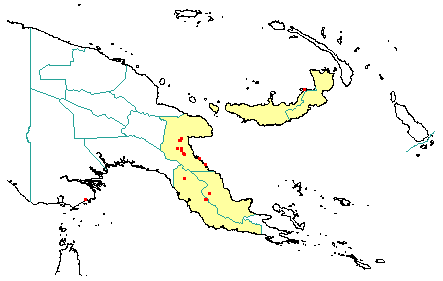
in PNGplants database
PNGTreesKey – Harpullia cupanioides Roxb. |
Barry Conn (NSW) & Kipiro Damas (LAE).
Guide to trees of Papua New Guinea
Copyright held by the authors, National Herbarium of New South Wales, and Papua New Guinea National Herbarium
Flora of India Vol. 2: 442 (1824)
Other Literature: P.W. Leenhouts & M. Vente, Flora Malesiana, Series 1 606-608 (1994) Fig. 46 (g & h).
Family: Sapindaceae
Dicotyledon
Timber Group: Occasional timber species Tradename: Tulipwood
Field Characters: Large canopy tree (up to 20 m high, rarely taller) or Small sub-canopy tree; Bole cylindrical (to slightly fluted, up to 70 cm diam., rarely to 100 cm); crooked (bole up to 10 m long); buttresses buttresses present; spines spines absent; aerial roots aerial roots absent; stilt roots stilt roots absent; Bark grey or brown, rough, fissured (slightly vertical) or pustular, lenticels rounded/swelling; Subrhytidome (under-bark) red or brown; less than 25 mm thick (c. 8 mm thick), 8.0-10.0; bark blaze with two layers; faintly to non-aromatic; outer blaze yellow or green, markings absent, smooth; inner blaze yellowish white or yellow (straw-coloured turning red-brown on exposure), with stripes (cinnamon-coloured markings), smooth (corky); bark exudate (sap) present, colourless, not readily flowing (spotty), colour changing on exposure to air, to pale red, not sticky; terminal buds not enclosed by leaves.
Indumentum: Complex hairs absent; stinging hairs absent; mature twig indumentum (hairs) absent.
Leaves: Leaves spaced along branches, spiral (leaves occurring singly at a node and arranged spirally up the branchlet), compound (a leaf made up from two or more leaflets); petiole present, not winged, attached to base of leaf blade, not swollen; leaves with three leaflets (trifoliate) or pinnate (unbranched with more than three leaflets) (mostly up to 6 leaflets, rarely 7); petiolule not swollen; rachis present, absent, absent; leaves without a terminal leaflet (the number of leaflets even - paripinnate), broadest below middle, 11.0-14.5 cm, 4.5-5.5 cm, leaflets alternate, slightly asymmetric; venation pinnate, secondary veins open, prominent, intramarginal veins absent; leaves lower surface pale green or green, upper surface green (glossy), indumentum (hairs) absent; absent; domatia absent; stipules absent.
Flowers: Inflorescence axillary, flowers on a branched axis, cones absent; flowers bisexual, stalked, flowers with many planes of symmetry, 7.0-9.0 mm long, diameter small (up to10 mm diam.); perianth present, with distinct sepals and petals whorls, inner perianth greenish white or green; 5, some or partly joined; stamens 5, present, free of each other, free of the perianth; ovary superior, carpels joined (when more than one), locules 2; styles solitary, 1.
Fruits: Infrutescence arranged on branched axis, fruit 15.0-20.0 mm long, orange, not spiny, non-fleshy, simple, dehiscent, capsule (2-valved); seeds 1-2, about 10 mm long, not winged, broad (as wide as long), seed 1-10 mm diam.
Distribution: Morobe, Central, Northern & New Britain.
 | Botanical records in PNGplants database |